|
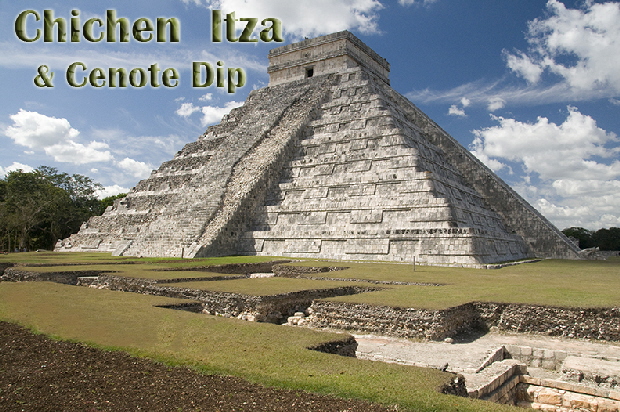
Chichen Itza and Cenote Dip
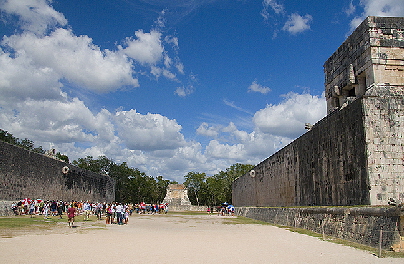 There's a reason this continues to be one of the most popular ruins to be visited in the Yucatan Peninsula of Mexico. It doesn't take much imagination to visualize the
size and complexity of the Mayan culture when this city was still functioning as a regional center. There's a reason this continues to be one of the most popular ruins to be visited in the Yucatan Peninsula of Mexico. It doesn't take much imagination to visualize the
size and complexity of the Mayan culture when this city was still functioning as a regional center.
Dominating the area is the impressive Temple of Kukulkan (Feathered Serpent) and carved serpent heads are
located on the western side of the Temple. In the Spring and Autumn Equinox thousands of people come to Chichen Itza to see one of the most interesting aspects
of this temple – as the sun slowly rises and sets, it casts a shadow of a serpent seemingly slithering down the northern side of the pyramid to the serpent's head at the base. Truly amazing.

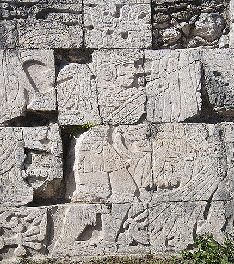 Another impressive archaeological remain is the Ball Court – the largest in ancient Mesoamerica. On each side of the court are walls 39 feet high and at each
end are what seemed to be temples where perhaps the most important residents could view the games. Carved and easily visible along the walls are depictions of the teams of players with
the equipment they wore and used during the ball game. Also on the walls are carvings of players being decapitated. Not sure if they were the winners or not. Another impressive archaeological remain is the Ball Court – the largest in ancient Mesoamerica. On each side of the court are walls 39 feet high and at each
end are what seemed to be temples where perhaps the most important residents could view the games. Carved and easily visible along the walls are depictions of the teams of players with
the equipment they wore and used during the ball game. Also on the walls are carvings of players being decapitated. Not sure if they were the winners or not.
The Temple of the Warriors is also another impressive building, a large stepped
pyramid flanked by rows of carved columns depicting warriors. Although nobody can walk on any of these structures any longer, from a distance you can see the
pyramid's summit and a sculpture of a human figure reclining with the head up and holding a tray over the stomach. Presumably this statue was the center of human sacrifice.
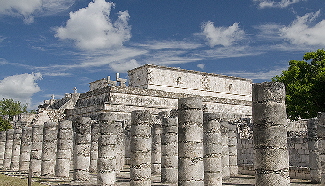 Along the base of the Temple of Warriors are carved columns that in ancient times supported a large roof system. Each of the columns is
intricately carved with warriors, jaguars, birds and other images representing the Mayan lifestyle. Nearby is a steam bath and an intricate water collection system, very advanced for its time. Along the base of the Temple of Warriors are carved columns that in ancient times supported a large roof system. Each of the columns is
intricately carved with warriors, jaguars, birds and other images representing the Mayan lifestyle. Nearby is a steam bath and an intricate water collection system, very advanced for its time.
There are many other buildings and temples scattered throughout the city, but one of the most impressive ones is a
temple housing an observatory. Its doors and windows are aligned with astronomical events and in
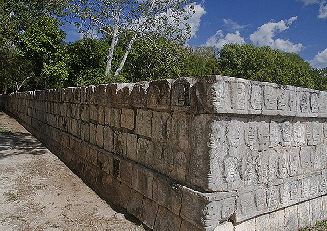 particular seemed to follow the path of the planet Venus, easily visible in the sky. particular seemed to follow the path of the planet Venus, easily visible in the sky.
Even though our visit to Chichen Itza was in late January, it was very hot so we recommend taking drinking water along and taking your time.
Unfortunately, there were many local vendors trying to sell visitors their wares within the archaeological site. Many visitors deemed this to be disturbing to the experience of walking among these
ruins. We recommend as the best way to visit would be to take a private or semi-private tour and not go on a large group tour bus organized by a tour operator.
The group tour bus typically stop at several resorts along the way which makes for a very long day and takes time away from that you can spend at the site.
Cenote Ik Kill Swim
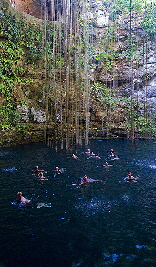
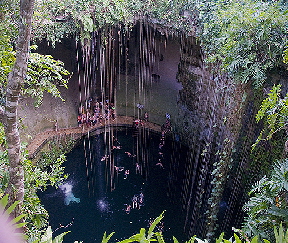 Fortunately there is a wonderful Cenote (natural well or sinkhole) at the Ik Kill Eco-archeological Park near Chichen-Itza, that can provide cooling
relief to anyone heated from walking around the ruins on the hottest of days! This is the place some call a Maya paradise where their kings and
courtesans reveled in direct contact with nature through meditation and relaxation. Today, the cenote has 90-foot walls that are covered with
lush jungle vegetation, and is enjoyed by masses as a place to cool down. Fortunately there is a wonderful Cenote (natural well or sinkhole) at the Ik Kill Eco-archeological Park near Chichen-Itza, that can provide cooling
relief to anyone heated from walking around the ruins on the hottest of days! This is the place some call a Maya paradise where their kings and
courtesans reveled in direct contact with nature through meditation and relaxation. Today, the cenote has 90-foot walls that are covered with
lush jungle vegetation, and is enjoyed by masses as a place to cool down.
Wear your swimsuit or change in the clean changing rooms and then take a plunge in
the cold fresh water! Walking up and down the stairs can be a slippery experience so wearing river shoes is advisable. After the first icy plunge, the next ones don't seem
so bad! Definitely worth it!
For great accommodations in the area check out our article on Barcelo Maya Palace
|